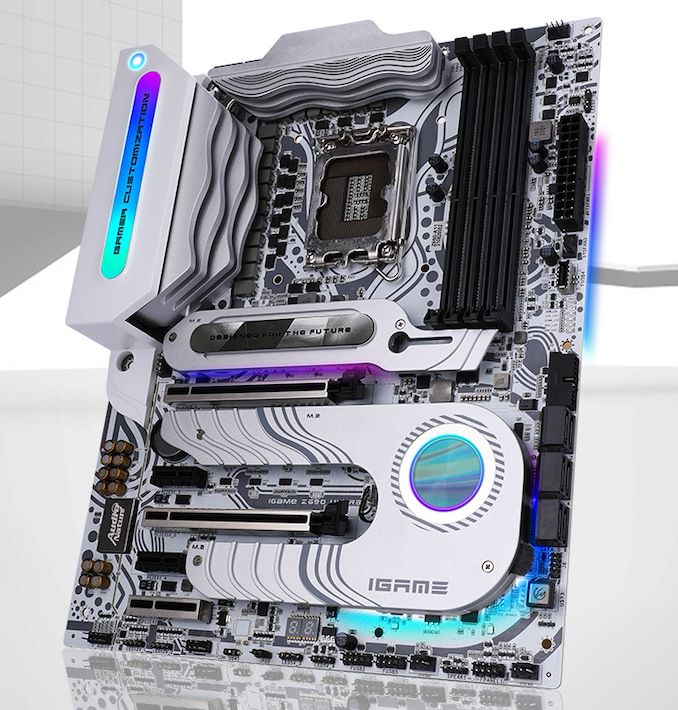The Intel Z690 Motherboard Overview (DDR5): Over 50+ New Models
by Gavin Bonshor on November 9, 2021 9:00 AM ESTColorful iGame Z690 Ultra D5
Colorful which primarily targets the Asian market also have a model ready for the launch of Alder Lake. Typically Colorful's options are limited but very funky in design and the latest Colorful iGame Z690 Ultra D5 is no exception to this. Equipped with a very modest range of features and controllers, it's aimed at the entry-level, but it has plenty of pizazz. On the design side, Colorful has gone with a white, silver, and grey aesthetic, with multiple areas of integrated RGB LED lighting. The iGame Z690 Ultra D5 features a wave-themed design on its power delivery heatsinks, with a U-shaped M.2 and chipset heatsink combined. Colorful is also advertising a 19-phase (18+1) power delivery, with dual 8-pin 12 V ATX CPU power inputs.
Looking at the feature set, Colorful isn't clear here on the expansion slots, as they sent us details with PCIe 4.0 and PCIe 3.0 slots, despite Alder Lake and the Z690 chipset offering PCIe 5.0 support. The top two full-length slots (PCIe 5.0/4.0) can operate at x16 and x8/x8, while the board also includes a half-length PCIe 3.0 x4 and two PCIe 3.0 x1 slots. Storage options include three PCIe 4.0 x4 M.2 slots, with six SATA ports capable of supporting RAID 0, 1, 5, and 10 arrays. Looking at memory support, Colorful has only given us compatibility of speeds of DDR5-4800, which could mean it has yet to QVL list various memory kits, but we do know the four memory slots can accommodate 128 GB of capacity.
While we don't currently have a rear panel image for the Colorful iGame Z690 Ultra D5, we know that it includes one USB 3.2 G2x2 Type-C, four USB 3.2 G2 Type-A, and two USB 2.0 ports. Networking is handled by an Intel I225-V 2.5 GbE controller and unspecified Wi-Fi 6 CNVi, while Colorful lists an 8-channel HD audio codec for the onboard audio.
We will update this page when we receive more information.











126 Comments
View All Comments
GeoffreyA - Saturday, November 13, 2021 - link
Certainly, there are tradeoffs, keeping a socket; but, as Mr. Tuvok would say, "Ryzen, you are an unending source of astonishment." There was a time when sockets even took CPUs from different manufacturers. I remember my Socket 7 motherboard, though I never tried it, could take a K5 and some Cyrix CPUs as well. Those 5x something, something. How things have changed.A short-lived socket can be a pain in the behind too. I was one of those unlucky folk who ended up with Socket 754 and missed out on dual-channel DDR and a long upgrade path. In any case, that computer went kaput after four years.
Oxford Guy - Wednesday, November 10, 2021 - link
Overclocking is for employees of motherboard companies.ECC RAM support should have been a standard feature from the beginning. Apple offered it on the Lisa in ‘83 and consumer computing has gone backward since.
Doublers, though... aren’t a bad thing as long as they’re implemented well — as I understand it. Better to have a good doubler implementation than a weak individual phase system. The main thing is to have a board meet the minimum spec for reliable (i.e. not overheating and/or failing) long-term support of its supported CPUs. Anything beyond that is unnecessary.
GeoffreyA - Saturday, November 13, 2021 - link
The problem with doublers is, they over-use it as a marketing technique to give the impression that a certain board has a large amount of phases.Oxford Guy - Saturday, November 13, 2021 - link
Weak phases with a mediocre/poor regulator aren’t necessarily better than ‘marketing phases’ via the use of doublers. That’s the case when the doublers are used a correctly.There are a lot of shenanigans, though — like not even utilizing the doubler fully but counting it as the doubling of phases. I also recall that one of the big tricks was putting extra chokes on the board to make it look like there are more phases.
GeoffreyA - Sunday, November 14, 2021 - link
Quite right, and one of the reasons why people have got to read a proper analysis of the VRM, or take a look at the lists on hardwareluxx for example.t.s - Tuesday, November 9, 2021 - link
Wish Intel go with their atv12vo. Or like business lines from HP, Dell, Lenovo, etc. 6 or 8 pin.shabby - Tuesday, November 9, 2021 - link
Mobo prices will go up even more, screw that.meacupla - Tuesday, November 9, 2021 - link
In the long term, I think the cost for ATX12VO will be cheaper.ATX12VO PSU will be cheaper than a comparable quality ATX PSU.
The BoM for 12V to 5V and 12V to 3.3V converters would go down, if mobo makers decide to stick to a single, standardized design.
With the way things are looking, electricity prices are unlikely to go down and continue to go up.
DigitalFreak - Tuesday, November 9, 2021 - link
All ATX12VO is doing is shifting the cost from the PSU to the motherboard.Wrs - Wednesday, November 10, 2021 - link
If mobo makers can stick to one design why can't PSU makers? They already conform to ATX.ATX 12 VO increases costs for piecemeal upgraders because of the simple observation that PSUs outlive motherboards. The question would be whether the power savings are worth it. For prebuilts they're comparing power savings to 0 net component cost so 12VO is already the norm.